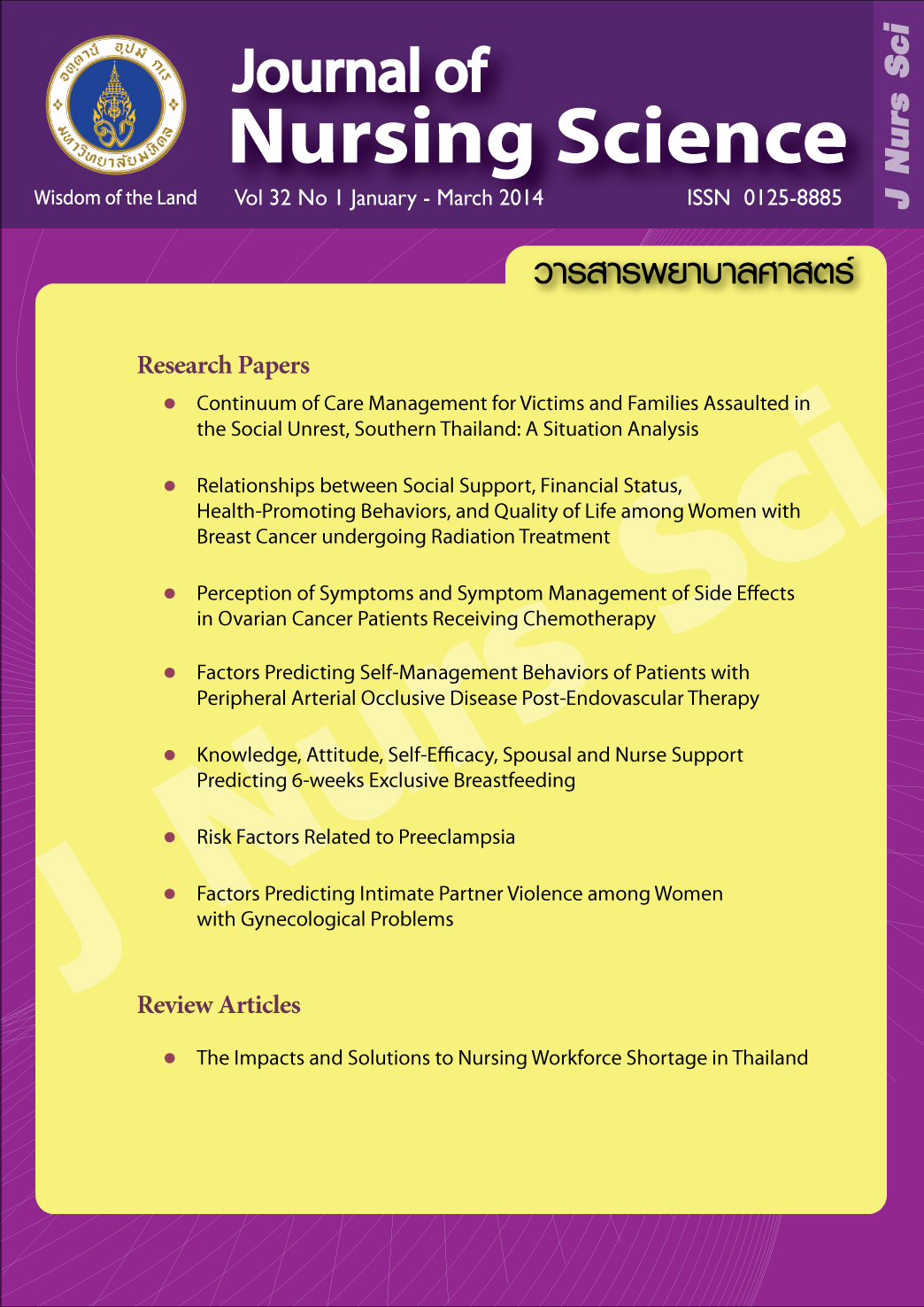Perception of Symptoms and Symptom Management of Side Effects in Ovarian Cancer Patients Receiving Chemotherapy
Main Article Content
Abstract
Purpose: To study the perception of common side effects of chemotherapy and symptoms that interfere daily life and strategies and effectiveness of symptoms management in ovarian cancer patients receiving chemotherapy.
Design: Survey research.
Methods: The subjects included 110 patients with ovarian cancer receiving chemotherapy in one university hospital in Bangkok. The instruments used in this study were 1) demographic data form; 2) side effects of chemotherapy questionnaires; 3) questionnaires on five severe symptoms that most interfere patient’s daily life, and open-ended questions of strategies and effectiveness of symptoms management. Data were analyzed by descriptive statistics.
Main findings: Paclitaxel and Carboplatin regimen was the chemotherapy most frequently used in these subjects. The most common symptoms of these patients were 1) alopecia, 2) fatigue, 3) numbness, 4) muscle pain, and 5) taste change. In addition, five symptoms that most interfere patient’s daily life were 1) fatigue, 2) muscle pain, 3) anorexia, 4) numbness, and 5) constipation. Fatigue was most managed by resting or taking a naps (67.5%). Muscle pain was managed by using medicine (43.8%), massage, hot and cold compress (22.9%). Anorexia and taste change were managed by changes in eating behavior (85.7%). Numbness was managed by exercise such as walk, hand and leg exercise (62.0%). Constipation was managed by changes in eating behavior (46.8%). The patients’ evaluation of severity and suffering of their symptoms were decreased.
Conclusion and recommendations: The findings of the study can be used to guide for instruction to ovarian cancer patients receiving chemotherapy and caregivers on how to deal and relieve suffering from side effects of chemotherapy.
Keywords: perception of symptoms, symptoms management, ovarian cancer, chemotherapy
การรับรู้อาการและการจัดการกับอาการข้างเคียงของผู้ป่วยมะเร็งรังไข่ที่ได้รับยาเคมีบำบัด
บทคัดย่อ
วัตถุประสงค์: เพื่อศึกษาการรับรู้อาการข้างเคียงจากยาเคมีบำบัดที่พบบ่อยและอาการที่รบกวนการดำเนินชีวิตประจำวัน วิธีในการจัดการกับอาการที่รบกวนการดำเนินชีวิตประจำวัน และผลลัพธ์จากการใช้วิธีดังกล่าวในผู้ป่วยมะเร็งรังไข่ที่ได้รับยาเคมีบำบัด
รูปแบบการวิจัย: เป็นการวิจัยเชิงสำรวจ
วิธีดำเนินการวิจัย: กลุ่มตัวอย่างคือผู้ป่วยมะเร็งรังไข่ที่ได้รับการรักษาด้วยยาเคมีบำบัดในโรงพยาบาลมหาวิทยาลัยแห่งหนึ่งในกรุงเทพมหานคร จำนวน 110 ราย โดยใช้ 1) แบบสอบถามข้อมูลส่วนบุคคล 2) แบบสอบถามอาการข้างเคียงจากยาเคมีบำบัด 3) แบบสอบถามอาการข้างเคียงที่รบกวนการดำเนินชีวิตประจำวันมากที่สุด 5 อันดับแรก แบบสอบถามปลายเปิดเกี่ยวกับวิธีการจัดการกับอาการข้างเคียงจากยาเคมีบำบัด และผลลัพธ์ของวิธีการจัดการนั้น วิเคราะห์ข้อมูลโดยใช้สถิติเชิงพรรณนา
ผลการวิจัย: กลุ่มตัวอย่างส่วนใหญ่ได้รับยาเคมีบำบัดสูตร Paclitaxel และ Carboplatin อาการข้างเคียงที่พบบ่อย คือ 1) ผมร่วง 2) เพลีย/ไม่มีแรง/อ่อนล้า/เวียนศีรษะ 3) ชาปลายมือ/ปลายเท้า 4) ปวดเมื่อยกล้ามเนื้อ/ปวดข้อ 5) เบื่ออาหาร/รับประทานอาหารไม่รู้รสชาติ อาการที่รบกวนการดำเนินชีวิตประจำวันมากที่สุด 5 อันดับแรก คือ 1) อาการเพลียไม่มีแรง อ่อนล้า เวียนศีรษะ 2) อาการปวดเมื่อยกล้ามเนื้อ/ปวดข้อ 3) เบื่ออาหาร/รับประทานอาหารไม่รู้รสชาติ 4) ชาปลายมือ/ปลายเท้า 5) ท้องผูก ผู้ป่วยจัดการกับอาการอ่อนเพลียด้วยการนอนพัก/นั่งพักมากที่สุด (ร้อยละ 67.5) อาการปวดเมื่อยกล้ามเนื้อ ใช้วิธีรับประทานยาแก้ปวด (ร้อยละ 43.8) รองลงมาใช้วิธีบีบนวด ประคบร้อน/เย็น (ร้อยละ 22.9) อาการเบื่ออาหาร ผู้ป่วยใช้วิธีปรับเปลี่ยนพฤติกรรมการรับประทานอาหาร (ร้อยละ 85.7) ชาปลายมือปลายเท้า ผู้ป่วยแก้ไขโดยการออกกำลังกายแขน-ขา การเดิน (ร้อยละ 62.0) และผู้ป่วยจัดการอาการท้องผูกโดยการปรับเปลี่ยนการรับประทานอาหาร (ร้อยละ 46.8) ผลลัพธ์ในการจัดการกับอาการเป็นไปในทางที่ดีคือ อาการและความทุกข์ทรมานลดลง
สรุปและข้อเสนอแนะ: ผลการศึกษาสามารถใช้เป็นแนวทางในการให้คำแนะนำแก่ผู้ป่วยมะเร็งรังไข่และผู้ดูแลในการบรรเทาอาการและความทุกข์ทรมานจากอาการข้างเคียงของยาเคมีบำบัด
คำสำคัญ: การรับรู้อาการ การจัดการอาการ มะเร็งรังไข่ ยาเคมีบำบัด
Article Details
Copyright Notice: Nursing Science Journal of Thailand has exclusive rights to publish and distribute the manuscript and all contents therein. Without the journal’s permission, the dissemination of the manuscript in another journal or online, and the reproduction of the manuscript for non-educational purpose are prohibited.

Disclaimer: The opinion expressed and figures provided in this journal, NSJT, are the sole responsibility of the authors. The editorial board bears no responsibility in this regard.


